Cervical osteochondrosis is a disease that is difficult for patients to diagnose initial treatment of doctors due to a large number of signs and a slowing course of the disease.
Development and manifestation of pathology
Osteochondrosis in the cervical spine is found among people who lead a sedentary lifestyle and perform sedentary work.
Logo
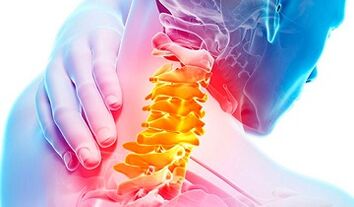
Signs of cervical osteocartilage degeneration are not only pain in the cervical area and upper shoulder area, but also headaches and chest pain.
Several syndromes are distinguished, each characterized by its own signs.
Rooser syndrome is caused by the pinching of nerve ends in the intervertebral space of the cervical vertebral space.Features:
- Pain in the cervical area;
- Pain in the forearm and hands;
- The tingling feeling of forearms, numbness.
Cardiac syndrome (or cardiac syndrome) is caused by infringement or stimulation of the nerve roots of the (or (or) the big chest muscles. In this case, these signs will act as pain in the heart area, which can be long and sharp during the rotation of the head, sneezing, or other movements of the neck (such as in the case of angina).
Driven arterial syndrome.In this case, the signs of osteochondrosis would be:
- Pulsational headaches in the occipital bone, frontal lobe (above the eyebrows), and time sections, are constant;
- Hearing equipment, vestibular equipment, vision (when cervical vertebrae bone disease is already in a neglected state).
Disease reflex syndrome.The signs of this syndrome are:
- Pulsational pain in the occipital bone of the head;
- The pain in the neck, even extends to the chest on the chest, spreads to the sides in the shoulder joints;
- Enhances pain after sleep and rapid head movement (including sneezing, coughing).
symptom
The symptoms of osteocartilage depend on which nerve root is damaged.In the 7 vertebrae in the cervical area, there are nerves.Their damage can cause developmental pain in osteochondrosis.
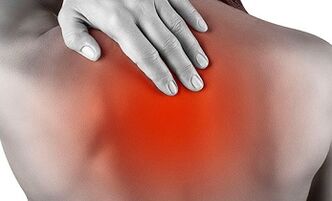
The vertebrae is considered from top to bottom and is represented by Roman numerals (CI, CII).The nerve ends between them are considered similar and are specified by Arabic numerals (C1, C2).The letter C indicates a cervix (from the cervix) department.
- If the nerve ends between the first and second vertebrae are damaged (C2), the main symptoms will be numbness and loss of sensitivity in the occipital bone.Later - the pain there.
- The damage to the nerve ending between the second and third vertebrae (C3) leads to impaired sensitivity in the area and later impaired sensitivity and language impairment (until the speech disorder).
- Damage to the nerve end between the third and fourth vertebrae (C4).In this case, the pain is concentrated on the clavicle, enters the heart area, and causes respiratory disorders.But the pain was before the numbness on the collar and shoulders.
- Damage to the C5 nerve root between the fourth and fifth vertebrae.If damaged, it responds to the sensitivity of the limbs, i.e. pain in the upper (in the hand) and lower limbs, as well as the forearm and external parts of the shoulders.
- Injury to nerve termination in the fifth, sixth and seventh vertebrae regions (the most common cervical osteochondropathy).Symptoms of pinching the ends of the C6 and C7 nerves are periodic numbness in the fingers and hands, pain in the neck, forearm and below - shoulder blade bone, posterior, and up to waist.
- Damage to nerve C8.The pain is concentrated around the neck and spreads through the forearm to the elbow and back to the lower limbs.Pain is previously lost in important areas (fingers, brushes), legs (fingers, feet), and skin.Blood circulation in the limbs is disturbed, which can affect the skin color of the hands and feet.
reason
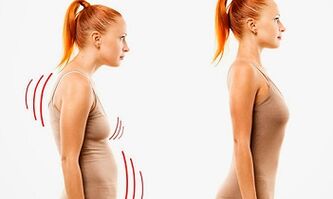
Cervical osteochondrosis is increasingly discovered in young populations.Explain that the disease occurs more because of lifestyle errors than hereditary tendencies.
Among genetic causes, not only are the genetic susceptibility to diseases differentiated, but also the existence of chronic diseases and genetic abnormalities in spinal development.
The list of causes of cervical osteochondrosis related to lifestyle is very extensive.These include:
- Improper nutrition, so I have too much weight, my body's metabolism is disturbed, and I lack vitamins and minerals.
- A sedentary lifestyle is caused by sitting or a unified work.Unstable physical exercise.
- Severe physical exercise.This includes professional exercise, frequent weight lifting.
- The curvature of the spine, violation of posture, the consequences of spinal injury, develop flat feet.
- Stress, often nerve stress.
diagnosis
The diagnosis of osteochondrosis can only be performed by a doctor.
Visual diagnosis
The patient will be examined and investigated initially when contacting a neurologist and an orthopedic surgeon.After palpation, the neck is evaluated for mobility and pain levels and the patient will be diagnosed with the hardware.
Radiography
This method will help determine the change in the cervical region and determine its extent.For a more accurate diagnosis, functional radiography can be used, which helps to "capture" changes in disc space from multiple aspects when pictures of the cervical spine are taken in various positions.
Magnetic resonance tomography
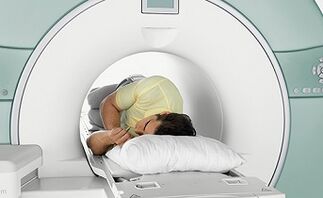
The method of obtaining tomographic images using magnetic pulses in which not only the pathology in the vertebral structure and the structure of vertebral cartilage can be diagnosed, but also the presence of vertebral hernia, their size and location can be determined.
When using MRI in the diagnostic results, changes will be visible in the vascular system and nerve ends of the vertebrae.
Computed tomography
This is a detailed analysis of the condition of the vertebral body and the results are processed using a laminator and a computer.This method not only allows the identification of changes in vertebrae and intervertebral space, but also analyzes the status of soft tissues, blood vessels, and ligaments.
Differential diagnosis
Once sent to one of the diagnostic procedures, the doctor will make a differential diagnosis - it will rule out the presence of other diseases in the body with similar symptoms.This will require a blood test, which is referred to other medical experts.
What are the dangers of ignoring bone cartilage?
Cervical osteochondrosis has periods of relief and aggravation.Often, unhealthy people who don’t go to the doctor in time and use painkillers feel relieved and forget about this problem until the next time.But the disease continues to develop and if you continue to ignore obvious symptoms, it can lead to serious complications in the cervical area.
Therefore, the consequences of the first and the first relatively "mild" osteochondrosis, herniation of the disc and hernia.
In the first case, the disc is herniated, which is displaced from its normal position between the vertebrae.At the same time, the connecting fibers (annulas) in the intervertebral disc remain intact and intact.
Even with sizes up to 1 mm, the cervical spine is very cues, and in other parts of the spine, these changes are not that dangerous.
After the protrusion is formed, the damage will affect the fiber ring - the inner jacket connecting the fibers to protect the core.Pathological changes in these structures lead to the formation of hernia in the intervertebral disc.The formation and development of hernia are accompanied by increased pain syndrome and unpredictable consequences.
If not treated, the more serious consequences of osteochondrosis are vascular diseases: plant vascular dystonia, hypertension and hypotension.
The formation of hernia in the intervertebral disc causes invasion of the proper location and function of the blood vessels, thereby squeezing the arteries that feed the brain.This leads to invasion of the brain oxygen intake and its normal functioning, which helps to form blood clots in blood vessels with further gaps.The result of disease development is stroke.
first aid
As osteochondrosis intensifies, the first question faced by patients: “How will it get rid of pain in the cervical vertebrae area?”
Drugs containing painkillers as well as painkillers will help eliminate the pain, and the limitations of exercise will help exercise.
When acute pain passes, anti-inflammatory pain relievers can be used for the next few hours and days before visiting the doctor.During periods of worsening and declining, you can use warming ointments that will help relieve tension in your neck and distract the pain.Ointment should be used without massage.
If a pain attack in the cervical spine finds you away from the first AID kit, such as applicators, pepper, mustard, a bag of sand, etc., can help you.

The applicator should be placed on a flat surface and lie on it so that it is under the cervical department, the occipital bone of the head and the shoulder joint.A few minutes will have to suffer from skin pain.Lying on the applicator should be done 2-3 times a day for 30-40 minutes.
Pepper patch or mustard sauce, you can use a bag with warm sand that should be applied to the sore points around your neck and let sit for a few minutes.The heat will relax the muscles and disperse the irritation of pepper or mustard sauce.
Exercise therapy (physical therapy exercise) is recommended, recommended for cervical osteochondrosis, which can relieve pain, but can relieve pain during mild periods.Practice should be performed regularly during remission – this will help to treat quickly and reduce the severity and frequency of the aggravation of the disease.
After receiving first aid and eliminating the pain, you need to seek help from your doctor as soon as possible.
treat
Different methods are used for the treatment of osteochondrosis.
Traditional Medicine
What is prevalent and effective is drug treatment.
Drug treatment
Using anesthesia tablets during the aggravation of osteochondrosis is more suitable for ambulances for patients.In this case, use analgesics.
Treatment is performed by other drugs - non-replacement anti-inflammatory drugs (NSAIDs).
Modern medicines use a new type of drug - a cartilage protector - a drug that restores cartilage tissue.
During the aggravation of the disease, when the pain syndrome is very obvious, a doctor prescribes an injection not only relieves the pain, but also has anti-inflammatory effects.
Blocking pain syndrome
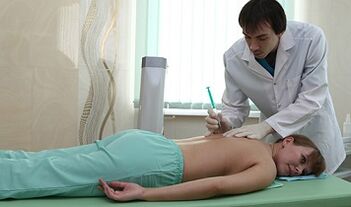
In advanced cases, it can resist pain medications and even inject pain medications during aggravated pain syndrome.Doctors can then use SO to be called "lockdown" - using injections to introduce anesthetic drugs into the source of pain.Therefore, the painful part of the spine is "disconnected" from the "composition" of the general nerves, and for some time (depending on the individual characteristics) the pain in that area will not interfere with the patient.
Experienced medical staff must have to perform this procedure because the wrongly completed procedure can lead to complications.Apart from personal intolerance to drugs, there are no contraindications in lockdown itself and can be carried out according to physical requirements.
Non-traditional medicine
Osteochondrosis is a disease that is not easy to treat, so you need to deal with it thoroughly.When treating osteochondrosis, use acupuncture.
Acupuncture is not a traditional medicine approach, but establishes its own attack in the fight against osteochondrhodonosis as it allows you to relieve pain and can be used during aggravated periods.It should be remembered that it does not bring about acupuncture, it can reduce symptoms, help to more easily metastasize periods of disease aggravate, improve neck and joint mobility, and recovery and regeneration processes activated by exposure, which helps to recover quickly.
physiotherapy
In addition to drug treatment, doctors also recommend physical therapy.
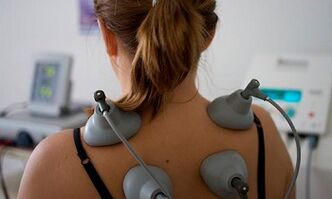
- Electrophoresis.In the case of osteochondrosis, electrophoresis is used with nonsteroidal anti-inflammatory drugs and analgesics to transfer the drug to the affected area and communicate in the required volume.The current enhances the effect of the drug and the process has an effect on the treatment.
- electrotherapyUse weak currents and magnetic therapy to use magnetic fields.They work in sore areas, relieve pain and improve blood circulation.During remission, it helps trigger the cell regeneration process, thereby accelerating the healing process.
Other physical therapists aim to increase blood circulation in the painful area, reduce edema and inflammation, pain, and overall increase in body immunity during treatment.
Treat with ointment
The use of ointment in osteocartilage is not the primary method in treatment and is prescribed as an additional measure that facilitates rapid recovery.The ointment used can be divided into several groups.
- Pain-Anti-inflammatory and anti-inflammatory drugs.This ointment includes analgesic and steroid anti-inflammatory substances.
- Heat the ointment.The main components of this type of ointment have an irritating effect on the skin, thereby increasing the blood supply to the area.This relieves stress, swelling, and relieves pain.
- Cartilage protectorIn the form of an ointment.The active substance reduces the cartilage fabric and reduces inflammation and pain.
- Massage ointment.Ointment for massage and self-confidence.There are natural anti-inflammatory substances, analgesic drugs, and regenerated substances of plant origin.
Massage and self-quality
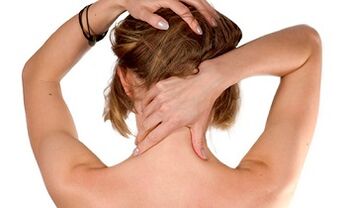
During the remission of the disease, osteochondral disease in the cervical spine must be massaged so that there is no increase in pain during the surgery.The massage rules are ten to fifteen courses, no more than once a quarter.Massage for cervical osteochondrosis is used as a procedure to enhance the impact and prevent osteochondrosis after treatment.
In the locations where the disease is distributed, tie areas and acupoint massage are performed by experts.A clear exercise from a massage therapist helps knead the muscles in the neck, improves blood circulation, relieves tension, and strengthens the neck muscles after the massage process, which will remain preventive for weeks or even months.
If necessary, you can do a light massage yourself.It is necessary to knead the muscles of the neck, the occipital part and the muscles of the muscles.In convenient locations and at any time, simple exercise may be the treatment and prevention of cervical osteochondrosis.
It is recommended to perform a few minutes of self-quality every day, it has no contraindications, and if accompanied by exercise, the pain is easily controlled by the patient alone.
Proper nutrition
In addition to classical treatments, physical therapy procedures and massages to treat and prevent osteochondrosis in the cervical spine, a full range of vitamins and minerals must also be used for proper nutrition.

The main problem is vitamins A and C, which can strengthen blood vessels.Vitamins B6 and B12 improve metabolism and amino acids in the body and help the nervous system work properly without failure.
During remission, complex vitamins are needed to restore and strengthen the body in general.
Traditional Medicine
Folk therapies for treating cervical osteochondrosis are divided into those that relieve pain and can be used to exacerbate, while the therapies used in courses are days or even weeks and have long-term therapeutic effects.
Anesthesia potato compression
You will need:
- Potato;
- 1-2 tablespoons of honey.One tablespoon of potatoes.
Preparation and application:
- Clean raw potatoes, grate.
- In a shallow bowl, mix with honey until smooth.
- The resulting mass was placed in a sore position, covered with polyethylene, and secured with a diaper.Keep compressed for 1-2 hours.
Infusion of carrot anesthesia
Alcohol tin agents in folk medicine are not only used for the soreness of friction anesthesia, but also for oral administration to give general enhancement and relief.
For infusion of carrots on vodka, you will need:
- Black radish - medium size;
- Vodka-50-70 ml;
- Honey – 3-4 tablespoons.spoon;
- Salt - 2 tablespoons.Spoon.
Preparation and application:
- Peel the radish and grate the pieces.
- In a shallow bowl, mix until smooth: radish, honey, salt, vodka.
- During the aggravation, wipe the cervical department with the mixture daily with the mixture.
- During the worsening period, 2 teaspoons inward on an empty stomach 2 times a day.
Ginger acidifying ointment
You will need:
- Ginger powder - 1 tablespoon.spoon;
- Garlic-2-3 cloves;
- butter.
Preparation and application:
- Fry the ginger powder in a pan with a small amount of butter.
- Peel the garlic, roast on fine crumbs or crush with minced.
- In a shallow bowl, mix fried ginger powder and garlic until smooth.
- The resulting ointment can be rubbed into worsening soreness or used as a compression spot and tied in a diaper for a few minutes until the feeling of burning on the skin.
Oil rubbed with garbage
During the remission of the disease, rub with an easy-to-massage oil for osteochondrosis and during rest periods of 10-15 days.
You will need:
- Oregano (grass) - a minority;
- 300-500 ml of olive oil (can be sunflower).
Preparation and application:
- Soreness (grass) trembles.
- Add oregano to a bottle of oil and inject it in a dark place for at least one day.
- Filter the oil and squeeze oregano out of the oil.
- Rub and massage with injected oil, and slight massage, and it is affected by osteochondrosis once.
Night compression made of horseradish
You will need:
- Horseradish leaves 1-3pcs.
- boiling water.
Preparation and application:
- Soak the leaves of horseradish in boiling water for a few seconds (soft).
- Apply the softened leaves to the affected areas in the bone cartilage and tie them with a diaper and tie them with a scarf.
- Leave compression from horseradish leaves at night.The feeling of light pinching is acceptable.
- The procedure is 5-7 procedures completed during the disease relief period and rests for 2-3 weeks.
Lemon Cocktail
You will need:
- Lemon - 1.
- 1 head of garlic (5-6 cloves);
- boiling water.
Preparation and application:
- Peel the lemons, peel them from the peel, seeds, grind them with a blender or grind them through the meat.
- Peel the garlic and grate with crushed or grated debris.
- Mix lemon and garlic in a jar or large bottle and pour 0.5 liter of the mixture.boiling water.
- Stick to the mixture for at least 12 hours (overnight).
- The resulting lemon cheese cocktail is consumed every day in the morning in an empty stomach.
You can store the cocktails in the refrigerator and prepare as needed.The cocktail process is 1 month.
Strawberry tea
You will need:
- Forest strawberries (fresh or dry) - 1 tablespoon.spoon;
- 1 cup boiling water.
Preparation and application:
- Floor - Sharp berries pour boiling water like tea.
- Persist for at least 10-15 minutes.
- Drink water for osteochondrhea every day.
Medical Sports
One of the causes of osteochondrosis is sexual myasthenia - a lack of physical activity in the context of a sedentary lifestyle.Just a few simple exercises will help alleviate the aggravation of the disease or prevent its appearance.
Practice "Home and Office"
Resist
- Press the palm onto the occipital bone on the head to make the neck muscles work hard.Resist with one hand.Keep the voltage for 10 seconds.
- Change the position of your hand, place it on your forehead, and now try to place it in front.It also resisted for about 10 seconds.
- Changing the position of the hand, putting it in the temple with palm (right hand towards the temple), also resisting the gesture on the head.Keep the voltage for 10 seconds.
- Change the hands and sides of the exercise and can now resist the left hand (left hand to left temple).Keep the voltage for 10 seconds.
- Alternately change the situation and repeat the exercise up to 5 times.
Stand at the head
- Stand upright and straighten your shoulders.
- Alternate to the right and left as much as possible to the head.
- Put your head to your chin to your neck.
- Make the same turn to each side as slowly as possible without tearing your chin from your neck.
- Perform the exercise slowly, repeating on each side of each position up to 5 times.
Standing with tilted head
- Rest your shoulders and pour your head slightly.
- Tilt your head left and right, trying to reach your shoulders with your ears.
- Perform the exercise slowly, repeating up to 5 times on each side.
Lying down exercises
Raise your legs
- Lie on your back, stretch your arms and legs freely.
- Put your legs together and pull your knees to your stomach while pulling your head up while trying to lift your eyes with your knees.
- Re-fix, lower your head, and straighten your legs and arms again along your body.Repeat, 5 times slow.
Headline says
- Lie on your belly, stretch your legs and place your arms along your body.
- Turn your head to the left, try to put it on the floor with your right ear, and then turn to the head on the right, and try to reach the floor with your left ear.
- Repeat the head turn up to 5 times in each direction.
When doing all exercises, remember that in the case of pain, you should refuse to exercise and consult a doctor.
prevention
Preventing osteochondrosis in the cervical spine is a healthy lifestyle:
- Sports and exercise (moderate).Positive for osteochondrosis, swimming will be the best assistant.It strengthens the muscles of the shoulders and neck.
- Eat a balanced diet.Includes products containing large quantities of calcium, magnesium, vitamins (cheese and dairy products, peas and other beans, nuts, fish and seafood).
- take a break.In every opportunity, we try to knead the muscles in our neck and back.
- Too much load.Don't wear too much and often severely (including a bag on your shoulder).
- Orthopedic pillows and mattresses.Use them if possible.
- Don't get fat.Too much weight can accelerate the development of osteochondrosis.Stand on the scale more frequently.
To control the condition of the cervical area, it is recommended to perform a diagnosis at least every 2-3 years: MRI or computed tomography.
Additionally, doctors should do a test at least once a year: surgeons and neuropathologists.If you start when the first sign appears, treatment for any disease is easier and faster.
























